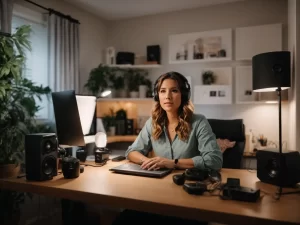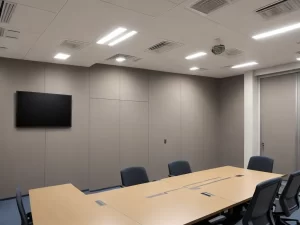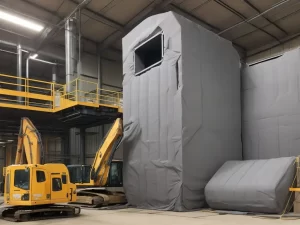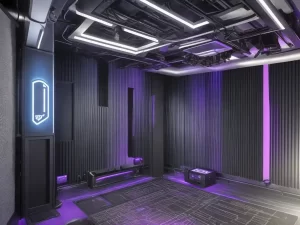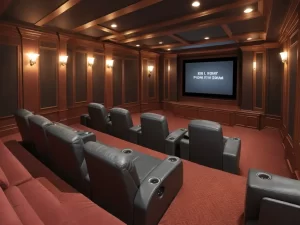Acoustic
EVA Foam in Acoustic Applications: A Comprehensive Guide to Soundproofing and Acoustic Treatments
- Introduction
- What is EVA Foam?
- The Science Behind EVA Foam's Acoustic Properties
- Benefits of Using EVA Foam in Acoustic Applications
- Limitations of EVA Foam in Acoustic Applications
- Case Studies and Real-world Applications
- How to Choose the Right Acoustic Material
- Frequently Asked Questions (FAQ)
- Conclusion
- Photo Gallery : Application Products in Acoustics
EVA Foam in Acoustic Applications: A Comprehensive Guide to Soundproofing and Acoustic Treatments
Introduction
In recent years, the quest for optimal sound quality has led to a surge in innovative acoustic solutions. One material that has caught the attention of experts and DIY enthusiasts alike is EVA foam. Known for its versatility in a wide range of applications, from sports equipment to crafts, EVA foam is now making waves in the acoustic world. But how effective is it? This comprehensive guide aims to explore the role of EVA foam in acoustic applications, shedding light on its properties, benefits, and limitations. Whether you’re looking to soundproof a home studio, an office, or even an industrial space, understanding the capabilities of EVA foam can be a game-changer. So, if you’ve ever wondered about the effectiveness of EVA foam in acoustic applications, you’re in the right place. Read on to discover how this remarkable material could be the solution to your acoustic challenges.
What is EVA Foam?
EVA foam, or Ethylene-Vinyl Acetate, is a closed-cell, flexible foam material known for its lightweight, shock-absorbing, and insulating properties. It’s a copolymer made from ethylene and vinyl acetate, which gives it its unique characteristics. EVA foam is highly versatile and is commonly used in a multitude of applications, ranging from sports equipment like yoga mats and shoe insoles to industrial uses such as packaging and automotive interiors.
Properties of EVA Foam
- Lightweight: One of the most attractive features of EVA foam is its light weight, which makes it easy to handle and install.
- Durability: EVA foam is highly durable, resistant to UV radiation, and can withstand various environmental conditions, making it a long-lasting material.
- Flexibility: The foam is extremely flexible, allowing it to be molded into various shapes and sizes, which is particularly useful in custom acoustic solutions.
- Shock Absorption: Known for its excellent shock-absorbing qualities, EVA foam is often used in sports equipment to minimize impact.
- Insulating Properties: EVA foam also serves as an effective insulator against heat, cold, and even sound, which brings us to its role in acoustic applications.
Common Uses Outside of Acoustic Applications
- Sports Equipment: EVA foam is widely used in yoga mats, gym flooring, and protective gear due to its cushioning and shock-absorbing capabilities.
- Crafts: The foam’s easy-to-cut nature makes it popular in crafting, where it’s used in everything from homemade costumes to children’s toys.
- Industrial Applications: In industries, EVA foam serves as packaging material, thermal insulation, and even as flotation devices.
- Automotive: The foam is also used in car seats, dashboards, and interior linings, offering both comfort and insulation.
The Science Behind EVA Foam’s Acoustic Properties
Understanding the science behind EVA foam’s acoustic properties is crucial for anyone considering its use in soundproofing or acoustic treatment projects. This section delves into the nitty-gritty of how EVA foam interacts with sound waves and what makes it an effective or, in some cases, limited choice for acoustic applications.
Sound Absorption Capabilities
- Porous Structure: EVA foam has a closed-cell structure, but its porous nature allows it to trap sound waves effectively. This is particularly useful for reducing echoes and reverberations in a room.
- Conversion to Heat: When sound waves hit the EVA foam, they are converted into heat energy, effectively reducing the sound’s intensity. This is known as sound absorption.
Sound Dampening Effects
- Density: EVA foam is not as dense as some other soundproofing materials like Mass Loaded Vinyl (MLV). However, its density is sufficient for dampening mid-range frequencies, making it a suitable choice for certain applications.
- Layering: The effectiveness of EVA foam in sound dampening can be increased by layering it with other materials, such as drywall or additional foam panels.
Frequency Range Effectiveness
- High Frequencies: EVA foam is generally less effective at blocking high-frequency sounds due to its lower density.
- Low Frequencies: On the other hand, its closed-cell structure makes it relatively effective at absorbing low-frequency sounds, which are often the most disruptive.
Comparing with Other Materials
- Mass Loaded Vinyl (MLV): MLV is denser and more effective at blocking sound but is also more difficult to install and more expensive. EVA foam offers a more lightweight and affordable option.
- Acoustic Foam: Unlike acoustic foam, which is usually open-cell, EVA foam is closed-cell. This makes EVA foam less effective at trapping high-frequency sounds but more effective at dampening low-frequency sounds.
By understanding the science behind EVA foam’s interaction with sound, you can make an informed decision about its suitability for your specific acoustic needs. Whether you’re looking to reduce noise in a home studio, an office setting, or an industrial environment, knowing what EVA foam can and cannot do is crucial.
Benefits of Using EVA Foam in Acoustic Applications
EVA foam’s unique properties make it a compelling choice for various acoustic applications. From its affordability to its ease of installation, here are some of the key benefits that make EVA foam stand out in the realm of acoustic solutions.
Cost-Effectiveness
- Affordable Material: One of the most significant advantages of EVA foam is its cost-effectiveness. Compared to other acoustic materials like Mass Loaded Vinyl (MLV) or specialized acoustic foam, EVA foam is generally more affordable.
- Savings on Installation: The lightweight nature and flexibility of EVA foam make it easy to install, saving you on labor costs.
Ease of Installation
- DIY-Friendly: EVA foam is a favorite among DIY enthusiasts because it’s easy to handle and install. You can easily cut it into various shapes and sizes to fit your specific needs.
- No Special Tools Required: Installing EVA foam panels or sheets doesn’t require any specialized tools, making the process even more straightforward.
Versatility in Various Settings
- Home Studios: EVA foam is an excellent choice for home studios where the goal is to reduce echo and improve sound quality.
- Offices: In office settings, EVA foam can help dampen ambient noise, making for a more focused work environment.
- Industrial Spaces: While not as effective as some other materials for heavy-duty soundproofing, EVA foam can still offer some level of noise reduction in industrial settings.
Additional Benefits
- Aesthetic Appeal: EVA foam panels come in various colors and designs, allowing you to enhance the aesthetic appeal of your space while also improving its acoustic properties.
- Safety: EVA foam is generally safe to use, with no off-gassing of harmful chemicals. However, it’s essential to check for fire-retardant options if that’s a concern for your specific application.
- Environmental Impact: Many EVA foam products are made from recycled materials, making them a more eco-friendly option compared to other acoustic solutions.
By understanding these benefits, you can see why EVA foam is becoming an increasingly popular choice for acoustic applications. Its combination of affordability, ease of installation, and versatility makes it a valuable addition to a wide range of soundproofing projects.
Limitations of EVA Foam in Acoustic Applications
While EVA foam offers several benefits in acoustic applications, it’s essential to be aware of its limitations to make an informed decision. This section will discuss some of the drawbacks and challenges you may encounter when using EVA foam for soundproofing or acoustic treatment.
Not Inherently Fire-Resistant
- Flammability: Standard EVA foam is not inherently fire-resistant. This can be a significant concern in specific settings, such as recording studios or industrial environments, where fire safety is a priority.
- Fire-Retardant Options: Some specialized EVA foam products are treated to be fire-retardant, but these options are generally more expensive.
Limited Frequency Range
- High Frequencies: EVA foam is less effective at blocking high-frequency sounds due to its lower density. This limitation can be a drawback in settings where complete sound isolation is required.
- Low Frequencies: While EVA foam can absorb some low-frequency sounds, it’s not as effective as denser materials like Mass Loaded Vinyl (MLV) for blocking out deep bass or rumbling noises.
Comparison with Other Materials
- Mass Loaded Vinyl (MLV): MLV is more effective at soundproofing but comes at a higher cost and is more challenging to install. If you’re looking for a material that can block out sound entirely, MLV might be a better option.
- Acoustic Foam: Acoustic foam is generally better at absorbing high-frequency sounds due to its open-cell structure. If your primary concern is echo reduction at higher frequencies, acoustic foam may be a better choice.
Environmental Concerns
- Non-Biodegradable: EVA foam is not biodegradable, which could be a concern for those looking for eco-friendly acoustic solutions.
- Off-Gassing: While EVA foam is generally safe and doesn’t off-gas harmful chemicals, some cheaper or lower-quality options might emit odors or volatile organic compounds (VOCs).
Specialized Needs
- Industrial Applications: For heavy-duty industrial applications where extreme soundproofing is required, EVA foam may not be the best choice due to its limitations in blocking out high-decibel noises.
By understanding these limitations, you can make a more informed decision about whether EVA foam is the right material for your acoustic project. While it offers several advantages, it’s crucial to weigh these against its drawbacks to find the most effective solution for your specific needs.
Case Studies and Real-world Applications
Real-world examples can provide invaluable insights into the effectiveness of EVA foam in acoustic applications. This section will explore various case studies and practical applications where EVA foam has been used, both successfully and less effectively, to address acoustic challenges.
Home Studios
Office Environments
Industrial Applications
Less Effective Applications
By examining these case studies, you can gain a nuanced understanding of where EVA foam excels and where it falls short in real-world acoustic applications. These insights can guide you in choosing the most appropriate material for your specific needs, helping you achieve the best possible acoustic results.
How to Choose the Right Acoustic Material
Choosing the right acoustic material for your project can be a daunting task, given the plethora of options available. This section aims to guide you through the decision-making process, highlighting the key factors you should consider when selecting EVA foam or other materials for your acoustic needs.
Understand Your Acoustic Goals
- Sound Absorption vs. Soundproofing: Are you looking to absorb sound to reduce echoes and reverberations, or are you aiming to block out external noise? Understanding your primary goal will help you choose the right material.
- Frequency Range: Consider the types of sounds you’re trying to manage. High-frequency sounds may require different materials than low-frequency sounds.
Budget Considerations
- Material Costs: EVA foam is generally more affordable than other acoustic materials like Mass Loaded Vinyl (MLV) or specialized acoustic foam. Make sure to factor in the cost when making your decision.
- Installation Costs: Some materials may require professional installation, adding to the overall cost. EVA foam is generally DIY-friendly, which can save you money on installation.
Ease of Installation
- DIY vs. Professional: If you’re comfortable with DIY projects, EVA foam can be an excellent choice. However, for more complex or large-scale projects, you might need to consider professional installation.
- Tools Required: EVA foam usually doesn’t require specialized tools for installation, whereas other materials might. Make sure you’re equipped to handle the installation process for the material you choose.
Aesthetic Preferences
- Visual Appeal: EVA foam panels come in various colors and designs, allowing you to match them with your room’s aesthetics. Other materials may not offer as much flexibility in terms of appearance.
- Room Usage: Consider the room’s purpose. A home studio may have different aesthetic requirements than an industrial setting, affecting your choice of material.
Safety and Environmental Concerns
- Fire Safety: If fire resistance is a priority, you may need to opt for specialized, fire-retardant EVA foam or another material altogether.
- Eco-Friendliness: If environmental impact is a concern, look for materials that are recyclable or made from recycled content. Some EVA foam products are eco-friendly, offering a sustainable option.
By carefully considering these factors, you can make a well-informed decision about the best acoustic material for your specific needs. Whether you opt for EVA foam or another option, the key is to align your choice with your project’s goals, budget, and other specific requirements.
Frequently Asked Questions (FAQ)
In this section, we’ll address some of the most commonly asked questions about EVA foam and its use in acoustic applications. These FAQs aim to provide quick answers to queries you may have, helping you make an informed decision for your acoustic project.
By addressing these frequently asked questions, we hope to clear up any uncertainties you may have about using EVA foam in acoustic applications. These answers should provide you with the information you need to decide whether EVA foam is the right choice for your project.
Conclusion
Choosing the right material for acoustic applications is a complex task that requires careful consideration of various factors, from sound absorption capabilities to budget constraints. EVA foam has emerged as a versatile and cost-effective solution for many acoustic challenges, offering a range of benefits such as ease of installation, affordability, and effectiveness in dampening mid-range frequencies.
However, like any material, EVA foam has its limitations. It’s not the best choice for complete soundproofing or for blocking out high-frequency noises. Additionally, standard EVA foam is not inherently fire-resistant, which may be a concern in specific settings. Therefore, it’s crucial to weigh the pros and cons, keeping in mind your project’s unique requirements.
Through real-world case studies, we’ve seen that EVA foam can be highly effective in certain scenarios, such as home studios and office environments, but less so in others like nightclubs or industrial settings with extreme noise levels. By understanding both the science behind EVA foam’s acoustic properties and its practical applications, you can make an informed decision tailored to your specific needs.
Whether you’re a DIY enthusiast looking to improve the acoustics of your home studio or a professional seeking to soundproof an industrial space, this comprehensive guide aims to provide you with the insights you need. Remember, the key to a successful acoustic project lies in choosing the right material and applying it effectively. EVA foam, with its unique set of properties, could very well be the solution you’ve been searching for.
Photo Gallery : Application Products in Acoustics











